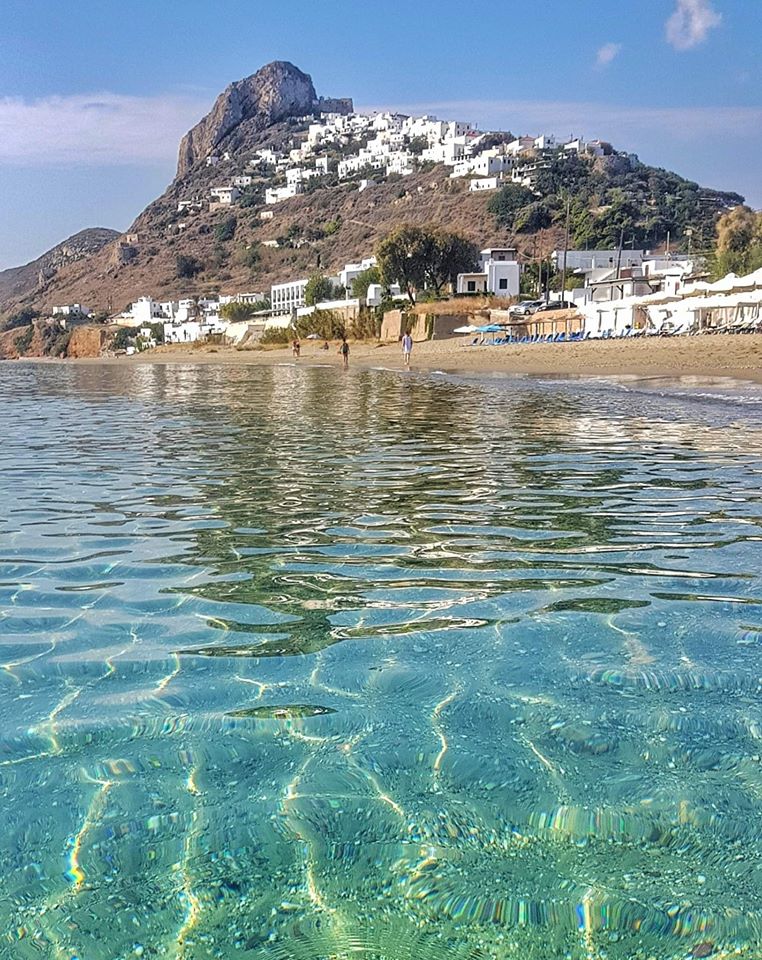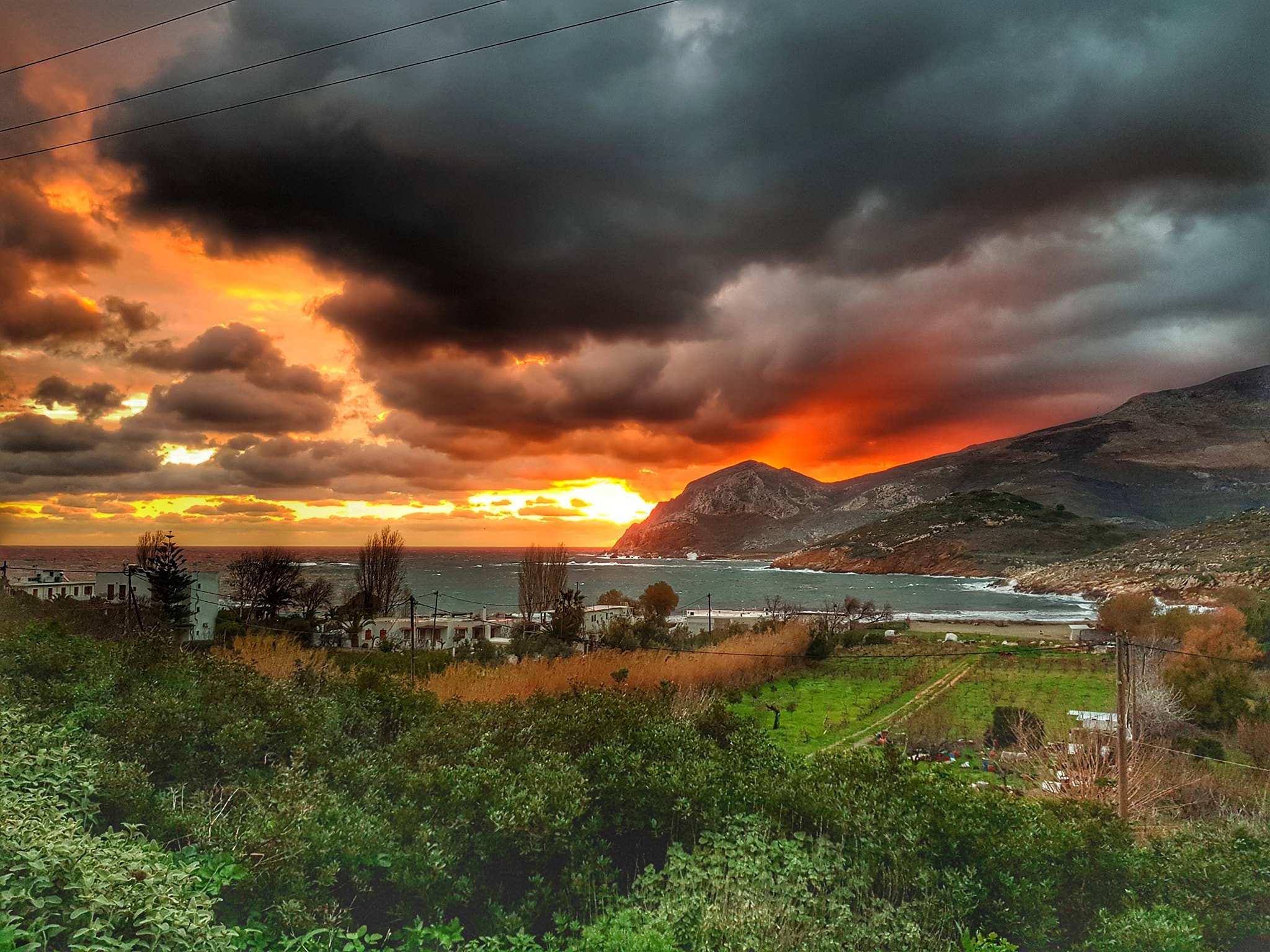History of Skyros

Many historians believe that our island was named after its wild stony soil. Skiron or Skyron means fragment of stone, or pebble (dictionary of D. Kyriakopoulos, ninth edition, pages 430 and 431).
The ancient names of Pelasgia and Dolopia have been mentioned but in the epics of Homer the island was written about four times, and the name Skyros was used. As stated in other ancient texts, the island has been inhabited by Kares, Cretans and Dolopes.
Skyros is closely associated with the demi-god Achilles, the son of the king of Fthia, Peleas, and the nymph Thetida, as well as with Theseus, the son of Aegeas, the King of Athens. It isn’t possiple, in the space available, to print a full history of Skyros. However, below is a brief outline of some historical details. In 470 B.C. the General Kimonas took over the island, which was strategically important for its connection with Ellispondos, and following the signs of an eagle, he found the grave of Theseus and brought his bones to Athens and laid them in the place which is now called Theseion.
For a century, the Skyreans lived under the rule of Athens, apart from a short period between 404 and 386 B.C. During this time, Skyros was in the hands of the Lacedaemoneans. The island remained under the peaceful and civilized rule of the Athenians until the Romans conquered it. There are stories about Achilles hiding in the royal palace of Lycomedes until he was discovered by Ulysses and taken from the island to fight in the siege of Troy. The son of Achilles and the princes Deidamia was Neoptolemus or Pyrros who later, also participated in the Trojan war. In 960, the temple of St. George was founded in Kastro. In 1204, when the empire was divided, the island was occupied by the Venetian brothers, Andreas and Jeremias Gyzis. They also seized the islands of Tenos, Mykonos, Skiathos and Skopelos. In 1354 the Duke of Naxos conquered Skyros and in 1403 it was taken over by the Sultan. Later it was handed over to the Byzantine Emperor, Emmanuel, and in 1453, given to the Venetians.
In 1538 it was conquered by the Turkish chief admiral, Hairedin Barbarossa, the infamous “Redbeard". In 1652 it was again taken by the Venetians, who remained until the Russian occupation in 1770. In 1821, in the National Fight for Independence, Skyros contributed both men and materials. Also, many Skyreans participated in the “Filiki Etaireia" and Skyros became a safety port for many fugitives, (Tourist Guide by X. Antoniadis & N. Xanthoulis).
Skyros is the largest island of the North Sporades and has an area of 215 square kilometers. Its itinerant population numbers around 3.000 (2011 census, 2.994 inhabitants). It lies east of Evia, 24 miles from the port of Kymi, and 26 miles south of Alonissos. Its geographical position is 36:11 to 38:59 lat. and 24:25 to 24:42 long. Administratively it belongs to the region of Karystia in the prefecture of Evia. A 4 kilometer long plane, running from Achilli up to Kalamitsa, “once covered by the sea", still divides the island into two parts. The north-west is covered by pine woods and lush vegetation.
The south-east is a complete contrast, mountainous, dramatic scenery. This area is where the Skyrian shepherds and goatherds graze their thousands of animals. For visitors who like walking and climbing, Skyros has several high mountains; Kohylas (794 meters) in the south, Olympos (390 meters) in the north, others include Marmaro (394 m.), Klari (331 m.), Afanes (327 m.), Oros (316 m.) and Ai Lias (294 m.). Surrounding Skyros, there are many smaller islands, some of which are green and used for grazing flocks of sheep and goats, for example Sarakiniko, sometimes called Despot’s, Plateia, Reneia, Skyropoula, Koulouri among others. there are also deserted islands and rocky islets, like Diavates, Myrmingonissia, Aloni, Kameles, Vrikolakonissia, Ai Armolaos, Vrahonissia in Achilli and many others.
The sea around these islands is wonderful for fishing. Skyros is famous for its sandy beaches, Magazia (Yialos), Mobs, Aghios Petros, Theotokos, Kyria Panagia, Atsitsa, Aghios Fokas, Pefkos, Aherounes, Kolymbada, Tris Boukes, Renes, Achilli, Mealos and the “official" nudist beach of Tou Papa to Homa. The Forests that cover around 32% of the island, consist mostly of pine trees. Considering the size of the island, there are few populated areas.
The main area being that of Skyros town itself. Originally a village, it is still called “Chorio" by the locals. Gradually it has spread and been joined to Magazia in the east. Kabos and Molos in the north and Plagia and Aghia in the south. Now it is a thriving, country town. 80% of the population of Skyros lives in the town. The town itself has many fascinating sights and places to visit. Start by exploring the tiny, winding streets, peep into the Skyrean houses, each one like a tiny museum with its copperware and local pottery adorning the walls. Climb to the ancient castle with the monastery of Aghios Georgios just beneath. Visit the town museums, between which stands the statue of Rupert Brooke. Breathe and absorb the atmosphere of ancient mythology, history, folklore and the pride of the local inhabitants. There are many publications about Skyros available in the local shops.
One of the better ones is “Skyros" a tourist guide, which is published by the Association of Skyreans. This association is based in Athens and has a museum and private offices (11 Koronis Street. Tel. 36.29.840). It also publishes the islands newspaper, “Skyriana Nea". The contribution of the As-sociation to the island is very important. Other tiny populated areas are Aspous, Atsitsa, Aherounes, Achilli, Kalamitsa, Kalikri, Klouthros, Pefkos, Trahi, Tryfadi and Flea. The port of Linaria in Skyros. is the second largest area. From here runs the boat and it houses the Port and customs authorities. There is also a church, two general stores, both of which have international telephone lines, two hotels, two tavernas, two cafes, a fish market, a petrol station, a shipping agent and a bar.
The main occupations of the islanders are; agriculture, breeding sheep and goats, tourism, building, traditional wood carving and pottery, commerce and fishing. Skyros is the home of two famous archaeologists. John Papadimitriou, who as a director of the Greek Archaeological Association and the President of EOT (Greek Tourist Organization) between 1957 and 1959, was concerned with the foundation of the archaeological museum and the Hotel Xenia, now Hydroussa, in Skyros. Dimitris Theoharis was a director of the archaeological association in Volos. The island is famous for many local products, among them the soft local “feta" cheese, fresh myzithra cheese, soft or hard, splendid honey and fava. All these local delicacies are difficult to find in the shops as they are mostly made for the family, however you may be lucky enough to be given some by the hospitable Skyreans.
The climate of Skyros is perfect, cool breezes in the summer keep the heat down and it has an average temperature of 7.3 degrees Celsius in the winter. The island has a daily ferry connection with Evia to the port of Kymi. The island boat leaves from Linaria at 08.00 and returns from Kymi at 17.00. These schedules may be changed, so it is wise to check before you travel. Aegean Airways provides air connection with Athens, and during summer 2 charter flights connect Skyros with Vienna (every Sunday) and Paris (twice a week). The journey takes about 25 minutes. During the summer months, there are connections by Ferry Boat with the neighboring islands and the mainland, through Kymi. Accurate information about the various methods of transportation can be obtained from the relevant agency (www.sne.gr). There are so many things to see and visit on the island.
- The natural beauty of the countryside, the mountains which change col-our according to the time of day or the season.
- The breathtaking view of the Kastro and the fascinating sights of the sur-rounding town.
- Beautiful sandy beaches, rocky coves and sea caves.
- The pine forests which stretch to Atsitsa, Afios Fokas, and surround Marmaro.
- The ancient ruins in Markesi, Palamari and Kalamitsa along with the ancient walls of the Kastro in Skyros town.
- The excavations in Palamari which were found by Liana Parlamas and Maria Theohari. More information is available about these sites in the book “Skyros in the Age of Copper".
- Traditional weddings still take place in Skyros. The women and the older men will still be seen wearing their traditional costumes and the Skyrean songs with Byzantine origins will still be sung.
- The Byzantine and post – Byzantine monuments in Kastro.
- The Monastery of Aghios Georgics and many of the 180 churches on the island.
- The traditional costumes and Skyrean sandals.
- The costumes during “Apo Kreas" the Lenten period before Easter, when everyone participating wears a mask so as to avoid recognition.
- The exquisite pottery, miniature carved furniture and other traditionally made wooden products.
- The miniature Skyrean horses, which are unique to the island.
- The Skyrean houses themselves with their traditional fireplaces and decoration.
- The two museums, archaeological and the folklore museum of M. Faltaits.
- The Gallery of Skyrian Sculptor Georgios Lambrou
- The square in which is the statue of Rupert Brooke, the British poet.
- The multi colored Skyrean marble which is cut from the mountain side.
In September 1989, Skyros was chosen by the International Federation of Young Architects (I.F.Y.A.) as the place for a convention for builders and architects from 18 different countries as it remains an excellent example of traditional architecture.








